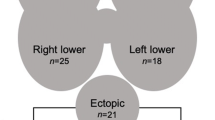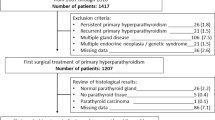Abstract
Background
Recurrent primary hyperparathyroidism (PHPT) presents a diagnostic challenge in localizing a hyperfunctioning gland. Although several imaging modalities are available for preoperative localization, 4D-CT is increasingly utilized for its ability to locate both smaller and previously unlocalized lesions. Currently, there is a paucity of data evaluating the utility of 4D-CT in the reoperative setting compared with ultrasound (US) and sestamibi. We aimed to determine the sensitivity of 4D-CT in localizing parathyroid adenomas in recurrent or persistent PHPT.
Methods
We performed a retrospective review of prospectively collected data from a tertiary-care hospital, and identified 58 patients who received preoperative 4D-CT with US and/or sestamibi between May 2008 and March 2016. Data regarding the size, shape, and number of parathyroid lesions were collected for each patient.
Results
A total of 62 lesions were identified intraoperatively among the 58 patients (6 with multigland disease) included in this investigation. 4D-CT missed 13 lesions identified intraoperatively, compared with 32 and 22 lesions missed by US and sestamibi, respectively. Sensitivity for correct lateralization of culprit lesions was 77.4% for 4D-CT, 38.5% for US, and 46% for sestamibi. 4D-CT was superior in lateralizing adenomas (49/62) compared with US (20/52; p < 0.001) and sestamibi (18/47; p < 0.001). The overall cure rate (6-month postoperative calcium < 10.7 mg/dL) was 89.7%. All patients with lesions correctly lateralized by 4D-CT were cured at 6 months.
Conclusion
4D-CT localized parathyroid adenomas with higher sensitivity among patients with recurrent or persistent PHPT compared with sestamibi or US-based imaging.

Similar content being viewed by others
References
Liddy S, Worsley D, Torreggiani W, Feeney J. Preoperative imaging in primary hyperparathyroidism: literature review and recommendations. Can Assoc Radiol J. 2017;68(1):47–55.
Griffith B, Chaudhary H, Mahmood G, Carlin AM, Peterson E, Singer M, Patel SC. Accuracy of 4-dimensional computed tomography in poorly localized patients with primary hyperparathyroidism. Am J Neuroradiol. 2015;36(12):2373–9.
Wilhelm SM, Wang TS, Ruan DT, Lee JA, Asa SL, Duh Q, et al. The American association of endocrine surgeons guidelines for definitive management of primary hyperparathyroidism. JAMA Surg. 2016;151(10):959–68.
Lebastchi AH, Donovan PI, Udelsman R. Paradigm shift in the surgical management of multigland parathyroid hyperplasia an individualized approach. JAMA Surg. 2014;149(11):1133–137.
Udelsman R, Donovan P, Sokoll L. One hundred consecutive minimally invasive parathyroid explorations. Ann Surg. 2000; 232(3):331–9.
Udelsman R. Six hundred fifty-six consecutive explorations for primary hyperparathyroidism. Ann Surg. 2002;235(5):665–70; discussion 670–2.
Beyer T, Solorzano C, Starr F, Nilubol N, Prinz R. Parathyroidectomy outcomes according to operative approach. Am J Surg. 2007;193(3):368–72; discussion 372–3.
Morris LF, Zanocco K, Ituarte PH, Ro K, Duh QY, Sturgeon C, et al. The value of intraoperative parathyroid hormone monitoring in localized primary hyperparathyroidism: a cost analysis. Ann Surg Oncol. 2010;17(3):679–85.
Lubitz C, Hunter G, Hamberg L, Parangi S, Ruan D, Gawande A, et al. Accuracy of 4-dimensional computed tomography in poorly localized patients with primary hyperparathyroidism. Surgery. 2010;148 (6):1129–37.
Mortenson MM, Evans DB, Lee JE, Hunter GJ, Shellingerhout D, Vu D, et al. Parathyroid exploration in the reoperative neck: improved preoperative localization with 4D-computed tomography. J Am Coll Surg. 2008;206(5):889–95; discussion 895–6.
Karakas E, Müller HH, Schlosshauer T, et al. Reoperations for primary hyperparathyroidism: improvement of outcome over 2 decades. Langenbecks Arch Surg. 2013;398(1):99–106.
Thompson GB, Grant CS, Perrier ND, Harman R, Hodgson SF, Ilstrup D, et al. Reoperative parathyroid surgery in the era of sestamibi scanning and intraoperative parathyroid hormone monitoring. Arch Surg. 1999;134(7):699–05.
Beland MD, Mayo-Smith WW, Grand DJ, Machan JT, Monchik JM. Dynamic MDCT for localization of occult parathyroid adenomas in 26 patients with primary hyperparathyroidism. AJR Am J Roentgenol. 2011;196(1):61–5.
Kuo L, Wachtel H, Fraker D, Kelz R. Reoperative parathyroidectomy: who is at risk and what is the risk? J Surg Res. 2014;191(2):256–61.
Kuhel WI, Kutler DI, Cohen M, Heineman T. Response to “parathyroid surgery: getting it right the first time”: parathyroid surgery: primum non nocere. Otolaryngol Head Neck Surg. 2016;154(2):397.
Day KM, Elsayed M, Beland MD, Monchik JM. The utility of 4-dimensional computed tomography for preoperative localization of primary hyperparathyroidism in patients not localized by sestamibi or ultrasonography. Surgery. 2015;157(3):534–39.
Galvin L, Oldan J, Bahl M, Eastwood J, Sosa J, Hoang J. Parathyroid 4D CT and scintigraphy: what factors contribute to missed parathyroid lesions? Otolaryngol Head Neck Surg. 2016;154 (5):847–53.
Hinson AM, Lee DR, Hobbs BA, Fitzgerald RT, Bodenner DL, Stack BC Jr. Preoperative 4D CT localization of nonlocalizing parathyroid adenomas by US and SPECT-CT. Otolaryngol Head Neck Surg. 2015;153(5):775–78.
Wagh ST, Razvi NA. Marascuilo method of multiple comparisons (an analytical study of caesarean section delivery). Int J Contemp Med Res. 2016;3(4):1137–40.
Suh YJ, Choi JY, Kim SJ, Chun IK, Yun TJ, Lee KE, et al. Comparison of 4D CT, ultrasonography, and sestamibi SPECT/CT in localizing single-gland primary hyperparathyroidism. Otolaryngol Head Neck Surg. 2015;152(3):438–43.
Ginsburg M, Christoforidis GA, Zivin SP, Obara P, Wroblewski K, Angelos P, et al. Adenoma localization for recurrent or persistent primary hyperparathyroidism using dynamic four-dimensional CT and venous sampling. J Vasc Interv Radiol. 2015;26(1):79–86.
Starker LF, Mahajan A, Björklund P, et al. 4D parathyroid CT as the Initial localization study for patients with de novo primary hyperparathyroidism. Ann Surg Oncol. 2011;18(6):1723–8.
Rodgers SE, Hunter GJ, Hamberg LM, et al. Improved preoperative planning for directed parathyroidectomy with 4-dimensional computed tomography. Surgery. 2006;140:932–40.
Bahl M, Sepahdari A, Sosa J, Hoang J. Parathyroid adenomas and hyperplasia on four-dimensional CT scans: three patterns of enhancement relative to the thyroid gland justify a three-phase protocol. Radiology. 2015;277(2):454–62.
Wang T, Cheung K, Farrokhyar F, Roman S, Sosa J. Would scan, but which scan? A cost-utility analysis to optimize preoperative imaging for primary hyperparathyroidism. Surgery. 2011;150(6):1286–94.
Cham S, Sepahdari AR, Hall KE, Yeh MW, Harari A. Dynamic parathyroid computed tomography (4dct4d-ct) facilitates reoperative parathyroidectomy and enables cure of missed hyperplasia. Ann Surg Oncol. 2015;22(11):3537–42.
Morris L, Lee S, Warneke C, Abadin S, Suliburk J, Romero Arenas M, et al. Fewer adverse events after reoperative parathyroidectomy associated with initial minimally invasive parathyroidectomy. Am J Surg. 2014;208(5):850–5.
Duke W, Vernon H, Terris D. Reoperative parathyroidectomy: overly descended superior adenoma. Otolaryngol Head Neck Surg. 2016;154(2):268–71.
McIntyre CJ, Allen JLY, Constantinides VA, Jackson JE, Tolley NS, Palazzo FF. Patterns of disease in patients at a tertiary referral centre requiring reoperative parathyroidectomy. Ann R Coll Surg Engl. 2015;97(8):598–02.
Disclosure
None.
Author information
Authors and Affiliations
Corresponding author
Rights and permissions
About this article
Cite this article
Hamidi, M., Sullivan, M., Hunter, G. et al. 4D-CT is Superior to Ultrasound and Sestamibi for Localizing Recurrent Parathyroid Disease. Ann Surg Oncol 25, 1403–1409 (2018). https://doi.org/10.1245/s10434-018-6367-z
Received:
Published:
Issue Date:
DOI: https://doi.org/10.1245/s10434-018-6367-z




